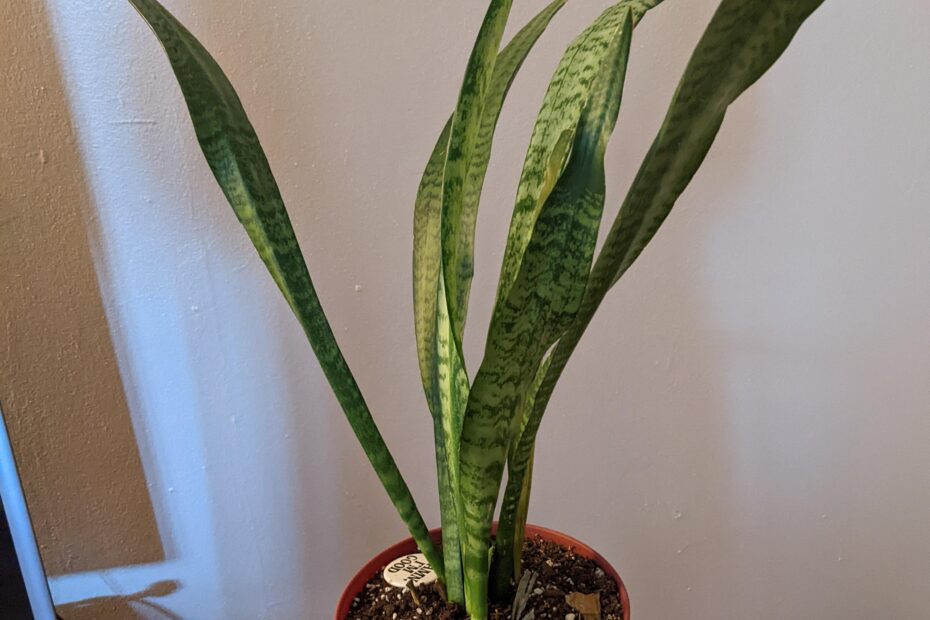In the whimsical world where leaves sway to their own rhythm, amidst the bustling flora and fauna resides a serpentine wonder known as the snake plant. With its piercing green stalks and elegant sword-shaped leaves, it stands as a stalwart symbol of resilience and tranquility. However, just as life itself dances between contradiction and harmony, one may find this steadfast beauty succumbing to a most peculiar fate. Alas, it seems our snake plant’s grace is compromised as it tumbles in an enigmatic catastrophe, falling over with an air of mystery. Join us on this botanical journey as we unravel the secrets behind our beloved snake plant’s puzzling decline.
Understanding the Issue: The Possible Causes for a Falling Snake Plant
If you notice your snake plant leaning or falling over, it’s important to identify the possible causes to help restore its upright growth. Despite being known for their resilience, even snake plants can experience some issues that lead to their downfall. Here are a few reasons why your snake plant might be toppling over:
- Rootbound: Snake plants have a tendency to become rootbound when they outgrow their containers. As a result, their roots become cramped and start circling the bottom of the pot, hindering proper stability and nutrient absorption.
- Improper watering: Over or underwatering can weaken the snake plant’s root system, making it susceptible to falling over. Inconsistent watering or using a pot without drainage holes can lead to waterlogged soil, causing root rot and eventual instability.
- Lighting issues: Snake plants thrive in bright, indirect light, but excessive shade or low lighting conditions can weaken their stems. Without adequate light, the snake plant may grow weak and struggle to maintain an upright position.
| Features | Tips |
|---|---|
| An upright strong stem | Ensure the pot has proper drainage |
| Firm, healthy leaves | Provide bright, indirect light |
| Well-draining soil | Water the snake plant only when the top inch of soil is dry |
By examining these potential causes and implementing the suggested tips, you can address the issue of your falling snake plant and promote its healthy growth once again.

Maintaining Upright Growth: Tips for Supporting and Straightening a Falling Snake Plant
Is your beloved snake plant losing its balance and starting to fall over? Don’t worry, we’re here to help you rescue your elegant green friend! Snake plants are known for their upright growth, but sometimes, even the sturdiest of plants can develop a case of the lean. Luckily, with a little care and support, you can bring your snake plant back to its glorious, vertical splendor.
First things first, let’s tackle the issue of providing support to your falling snake plant. A support system will not only prevent further leaning but also promote healthy growth. Here are a few tried and tested methods:
-
Staking: Gently insert a bamboo stake or a dowel into the soil, making sure it goes deep enough to anchor your snake plant. Then, use soft garden twine or plant ties to secure the stalks to the stake, creating a straight and stable support structure.
-
Repotting: If your snake plant is top-heavy and prone to falling over, consider repotting it into a slightly larger container. This will provide more stability by allowing the roots to spread and anchor the plant firmly in the soil.
-
Division: Sometimes, a snake plant can become top-heavy due to overcrowding. Dividing the plant into two or more smaller ones not only solves this issue but also encourages healthier growth. Simply remove the plant from its pot, gently separate the roots, and replant each section in its own container.
But wait, there’s more! To ensure your snake plant maintains its upright growth in the long run, here are a couple of additional tips to keep in mind:
-
Proper water and lighting: Snake plants thrive in moderately dry conditions and prefer indirect sunlight. Avoid overwatering, as it can lead to root rot and weaken the plant’s structure. Additionally, rotate your plant periodically to ensure it receives equal light distribution, promoting uniform growth.
-
Regular cleaning: Dust can accumulate on a snake plant’s leaves, hindering its ability to photosynthesize properly. Wipe the leaves gently with a soft cloth or sponge to remove any dust, allowing the plant to breathe and grow more efficiently.
Remember, your snake plant might take some time to fully recover and regain its upright stance. Be patient and continue providing the necessary support and care. In no time, your snake plant will stand tall, adding beauty and elegance to your space once again.
Preventing Future Falling: Proactive Measures to Ensure a Strong and Healthy Snake Plant
A snake plant falling over can be a cause for concern, but there are several proactive measures you can take to ensure that your beloved plant stays strong and healthy. By implementing these tips and features, you can prevent future falling episodes and provide the ideal environment for your snake plant to thrive.
Firstly, make sure to provide adequate support for your snake plant. This can be achieved by using bamboo stakes or plant supports. Gently tie the plant to the stake, taking care not to damage the leaves. This will help provide additional stability and prevent the plant from toppling over.
| Features and Tips | Description |
|---|---|
| Well-Draining Soil | Use a well-draining soil mix to prevent waterlogging, which can lead to root rot and weakened plant structure. |
| Regular Rotation | Rotate your snake plant every few weeks to ensure even growth and prevent leaning towards the light source. |
| Avoid Overwatering | Snake plants are drought-tolerant, so make sure to let the soil dry out between waterings to prevent root rot. |
Additionally, consider the placement of your snake plant. Avoid placing it in high-traffic areas or near doorways where it may be accidentally bumped into. It is also important to keep the plant away from strong draughts or heating vents, as these can cause the leaves to dry out and weaken the overall structure.
By taking these proactive measures and implementing the suggested features and tips, you can ensure that your snake plant remains upright and healthy, providing you with its beautiful foliage and air-purifying benefits for years to come.

Expert Recommendations: Enhancing Care and Reinforcing Stability for Your Snake Plant
Are you noticing your snake plant falling over? Don’t worry, we’ve got you covered with expert advice on how to enhance care and reinforce stability for your beloved foliage. Whether it’s due to its incredible growth, weak root system, or simply an imbalance in the pot, there are a few simple steps you can take to ensure your snake plant stays upright and healthy.
1. Repotting: Assess the size of your snake plant and consider repotting it into a larger container. This will provide more space for the roots to expand and anchor the plant firmly. Use a well-draining potting mix and ensure that the plant sits at a similar depth as it was in its previous pot.
2. Staking: A useful technique to provide extra support is staking. Gently insert a sturdy stake, such as bamboo or wooden dowel, into the soil near the base of the plant. Secure the plant to the stake using soft ties or plant-friendly wires. This will help maintain its upright posture until the roots establish a stronger hold.
| Features | Tips |
|---|---|
| Soil Drainage |
|
| Sunlight |
|
| Temperature and Humidity |
|
By following these recommendations and implementing these tips, rescuing your snake plant from its falling-over predicament is well within your green-thumbed capabilities. Remember to observe your plant closely, adjust its care routine accordingly, and enjoy the beauty of your thriving snake plant.
Frequently Asked Questions
Q: Oh no! My snake plant is falling over. What should I do?
A: Fear not, green enthusiast! Here are three questions and answers to salvage your leaning snake plant and restore its upright glory.
Q: Why is my snake plant toppling over?
A: As stoic as they may seem, snake plants are not immune to a potential imbalance issue. There could be a few reasons behind your plant’s precarious posture. Firstly, overwatering could lead to softened roots, weakening its grip on the soil. Additionally, snake plants that have outgrown their containers may struggle to maintain stability. Lastly, inadequate light conditions might cause your plant to stretch and lean towards the nearest light source like an anguished sunseeker.
Q: How can I save my slumping snake plant?
A: There are a couple of easy fixes to help your snake plant stand tall once again. If you suspect overwatering, allow the soil to dry out before watering again, ensuring proper drainage. For plants outgrowing their pots, consider repotting into a larger container, providing ample space for growth and stability. Remember to use well-draining soil to prevent excess moisture from causing further root damage. If lighting is the culprit, relocate your snake plant to a brighter spot, but ensure it isn’t exposed to direct sunlight, as it may scorch the leaves.
Q: Can I prop my snake plant up without repotting it?
A: Absolutely! If repotting seems intimidating or unnecessary, there’s an alternative method to lend support to your snake plant. First, locate a sturdy stake, such as a bamboo skewer or a thin stick. Insert it gently into the soil near the base of the leaning plant while being cautious not to damage any roots. Then, carefully tie the stem to the stake using soft plant ties or string. This makeshift crutch will provide temporary assistance until your plant regains strength and stability.
Remember, dear plant enthusiast, even the most resilient snake plant may stumble at times. With a touch of patience, a sprinkle of care, and a dash of creativity, you’ll soon have your precious foliage standing tall and proud once again! As we bid adieu to our serpent-like friend, we hope this article has shed light on the mysterious phenomenon of the falling snake plant. While it may seem like a calamitous event, fear not, dear plant enthusiasts! Remember, even the mighty snake can succumb to gravity’s playful clutches.
So, if your beloved snake plant has had a tumble or two, don’t despair. Be it the mischievous antics of an unruly cat or an excess of water at its rooty feet, there are solutions aplenty. From wooden dowels acting as supportive crutches to delicate re-potting maneuvers, we trust that your snake plant will soon regain its upright splendor.
In the realm of plant parenthood, we learn to navigate the unexpected twists and turns along the way. And just as the snake gracefully slithers through various terrains, our resilient snake plants will undoubtedly find their way back into our hearts, standing tall and proud.
So, fellow green thumbs, fear not the falling snake plant! Embrace the opportunity to guide and nurture your resilient companion back to its vertical prowess. Remember, we are but gardeners in this vast, interconnected ecosystem, and our efforts, no matter how small, make a world of difference.
As we conclude this enthralling odyssey of our fallen serpent, let us take away a valuable lesson: in the realm of plant care, patience and ingenuity will always triumph. So, dear readers, march forth into your garden with renewed vigor, armed with newfound wisdom and a touch of creative finesse. And may your snake plants sway ever gracefully, their roots firmly anchored in the fertile soil of your loving care.
- When to Put Weed and Feed on Lawn in Michigan - October 16, 2023
- When to Fertilize Potatoes Plants - October 16, 2023
- Can You Plant Clover in the Spring - October 16, 2023
Contents
- 1 Understanding the Issue: The Possible Causes for a Falling Snake Plant
- 2 Maintaining Upright Growth: Tips for Supporting and Straightening a Falling Snake Plant
- 3 Preventing Future Falling: Proactive Measures to Ensure a Strong and Healthy Snake Plant
- 4 Expert Recommendations: Enhancing Care and Reinforcing Stability for Your Snake Plant
- 5 Frequently Asked Questions

